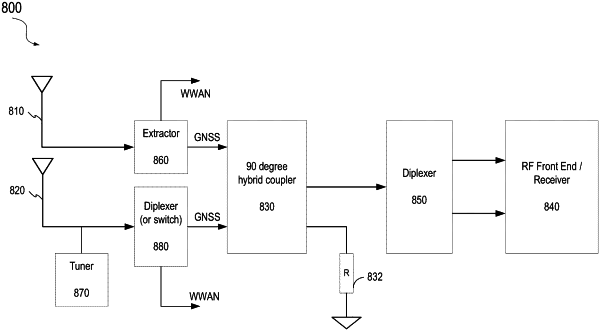| CPC G01S 19/36 (2013.01) [G01S 19/32 (2013.01); G01S 19/37 (2013.01); H01Q 9/42 (2013.01); H04B 1/52 (2013.01); H04B 1/58 (2013.01)] | 19 Claims |

|
1. A Global Navigation Satellite System (GNSS) receiver comprising:
a first linear polarization antenna configured to receive a radio frequency signal conforming to a first wireless communication technology, wherein the radio frequency signal conforming to the first wireless communication technology includes a first linear polarization component of a GNSS signal;
a second linear polarization antenna configurable to receive, based on an operation condition associated with the GNSS receiver, a second linear polarization component of the GNSS signal, and a radio frequency signal conforming to a second wireless communication technology;
a hybrid coupler including:
a first port electrically coupled to the first linear polarization antenna;
a second port electrically coupled to the second linear polarization antenna; and
a third port configurable to output a combined GNSS signal of the first linear polarization component of the GNSS signal and the second linear polarization component of the GNSS signal to a radio frequency (RF) receiver,
wherein a difference between a phase delay from the second port to the third port and a phase delay from the first port to the third port is between 60° and 120°; and
an n-plexer between the second linear polarization antenna and the second port of the hybrid coupler, the n-plexer configured to: separate the second linear polarization component of the GNSS signal and the radio frequency signal conforming to the second wireless communication technology, and send the second linear polarization component of the GNSS signal directly to the second port of the hybrid coupler and not directly to the RF receiver.
|